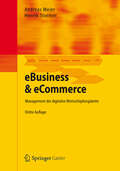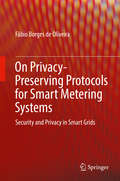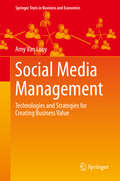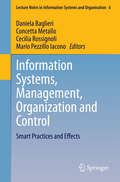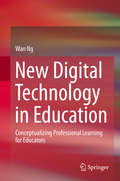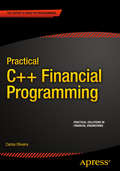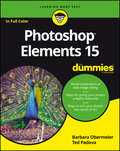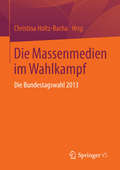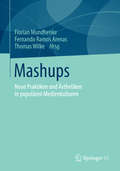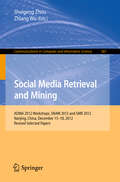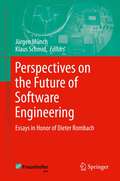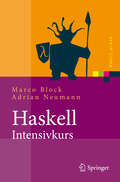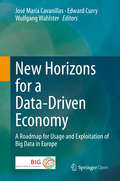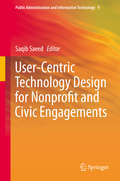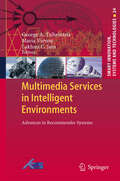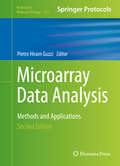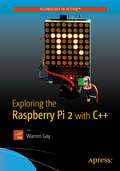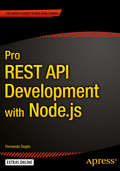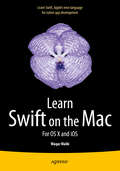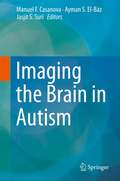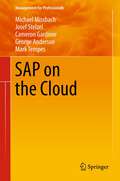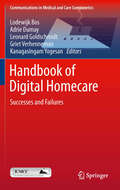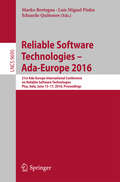- Table View
- List View
eBusiness & eCommerce
by Andreas Meier Henrik StormerIm Mittelpunkt des Fachbuchs stehen die Glieder der digitalen Wertschöpfungskette - jedem einzelnen ist ein eigenes Kapitel gewidmet. Neben Geschäftsmodellen und Business Webs werden digitale Beschaffungs- und Marketingprozesse behandelt, Verhandlungsprozesse, Sicherheitsfragen sowie das Lieferanten- und Kundenbeziehungsmanagement. Anwendungsbeispiele und eine durchgehende Fallstudie illustrieren die Vorgehensweisen. Für die 3. Auflage wurden Methoden und Techniken des Web 2.0 (Social Web) und des Web 3.0 (Semantic Web) eingearbeitet.
On Privacy-Preserving Protocols for Smart Metering Systems
by Fábio Borges de OliveiraThis book presents current research in privacy-preserving protocols for smart grids. It contains several approaches and compares them analytically and by means of simulation. In particular, the book introduces asymmetric DC-Nets, which offer an ideal combination of performance and features in comparison with homomorphic encryption; data anonymization via cryptographic protocols; and data obfuscation by means of noise injection or by means of the installation of storage banks. The author shows that this theory can be leveraged into several application scenarios, and how asymmetric DC-Nets are generalizations of additive homomorphic encryption schemes and abstractions of symmetric DC-Nets. The book provides the reader with an understanding about smart grid scenarios, the privacy problem, and the mathematics and algorithms used to solve it.
Social Media Management
by Amy Van LooyThis undergraduate textbook adopts the perspective of organizations - not individuals - and clarifies the impact of social media on their different departments or disciplines, while also exploring how organizations use social media to create business value. To do so, the book pursues a uniquely multi-disciplinary approach, embracing IT, marketing, HR and many other fields. Readers will benefit from a comprehensive selection of current topics, including: tools, tactics and strategies for social media, internal and external communication, viral marketing campaigns, social CRM, employer branding, e-recruiting, search engine optimization, social mining, sentiment analysis, crowdfunding, and legal and ethical issues.
Information Systems, Management, Organization and Control
by Cecilia Rossignoli Daniela Baglieri Concetta Metallo Mario Pezzillo IaconoThis book explores the diversity of topics, views and perspectives focused on the relationship between information systems, organizations and managerial control. It brings together theories and practices by a diverse group of scholars working in different disciplines: organization, management, accounting, information systems development, human-computer interaction. The volume is divided into three sections, each one focusing on a specific theme: organizational change, innovation and information and communication technologies; organizational control, accounting and information systems; information, knowledge and project management practices. The book is based on a selection of the best research papers - original double blind peer reviewed contributions of the annual conference of the Italian chapter of AIS, held in Milan, Italy in December 2013.
New Digital Technology in Education
by Wan NgThis book addresses the issues confronting educators in the integration of digital technologies into their teaching and their students' learning. Such issues include a skepticism of the added value of technology to educational learning outcomes, the perception of the requirement to keep up with the fast pace of technological innovation, a lack of knowledge of affordable educational digital tools and a lack of understanding of pedagogical strategies to embrace digital technologies in their teaching. This book presents theoretical perspectives of learning and teaching today's digital students with technology and propose a pragmatic and sustainable framework for teachers' professional learning to embed digital technologies into their repertoire of teaching strategies in a systematic, coherent and comfortable manner so that technology integration becomes an almost effortless pedagogy in their day-to-day teaching. The materials in this book are comprised of original and innovative contributions, including empirical data, to existing scholarship in this field. Examples of pedagogical possibilities that are both new and currently practised across a range of teaching contexts are featured.
The Manager's Guide to Web Application Security:
by Ron LepofskyThe Manager's Guide to Web Application Security is a concise, information-packed guide to application security risks every organization faces, written in plain language, with guidance on how to deal with those issues quickly and effectively. Often, security vulnerabilities are difficult to understand and quantify because they are the result of intricate programming deficiencies and highly technical issues. Author and noted industry expert Ron Lepofsky breaks down the technical barrier and identifies many real-world examples of security vulnerabilities commonly found by IT security auditors, translates them into business risks with identifiable consequences, and provides practical guidance about mitigating them. The Manager's Guide to Web Application Security describes how to fix and prevent these vulnerabilities in easy-to-understand discussions of vulnerability classes and their remediation. For easy reference, the information is also presented schematically in Excel spreadsheets available to readers for free download from the publisher's digital annex. The book is current, concise, and to the point--which is to help managers cut through the technical jargon and make the business decisions required to find, fix, and prevent serious vulnerabilities.
Practical C++ Financial Programming
by Carlos OliveiraPractical C++ Financial Programming is a hands-on book for programmers wanting to apply C++ to programming problems in the financial industry. The book explains those aspects of the language that are more frequently used in writing financial software, including the STL, templates, and various numerical libraries. The book also describes many of the important problems in financial engineering that are part of the day-to-day work of financial programmers in large investment banks and hedge funds. The author has extensive experience in the New York City financial industry that is now distilled into this handy guide. Focus is on providing working solutions for common programming problems. Examples are plentiful and provide value in the form of ready-to-use solutions that you can immediately apply in your day-to-day work. You'll learn to design efficient, numerical classes for use in finance, as well as to use those classes provided by Boost and other libraries. You'll see examples of matrix manipulations, curve fitting, histogram generation, numerical integration, and differential equation analysis, and you'll learn how all these techniques can be applied to some of the most common areas of financial software development. These areas include performance price forecasting, optimizing investment portfolios, and more. The book style is quick and to-the-point, delivering a refreshing view of what one needs to master in order to thrive as a C++ programmer in the financial industry. Covers aspects of C++ especially relevant to financial programming. Provides working solutions to commonly-encountered problems in finance. Delivers in a refreshing and easy style with a strong focus on the practical. What you'll learn Understand the fundamental problem types in the financial market. Design algorithms to solve financial programming problems. Extend C++ through Python extensions and LUA modules. Employ third-party numeric libraries such as those from Boost. Properly engage key C++ features such as templates and exception handling. Benefit from new features in C++14, such as auto variables and closures. Who this book is for Practical C++ Financial Programming is for professionals or advanced students who have interest in learning C++ financial programming, especially in preparation for a professional career. Readers should have a working-knowledge of programming in C, C++, or some other C-like language. The book is also useful to current practitioners at financial institutions as a ready-reference to common development problems and techniques. Table of Contents The Fixed-Income Market The Equities Market C++ Programming Techniques in Finance Common Libraries for Financial Code Designing Numerical Classes Plotting Financial Data Linear Algebra Interpolation Calculating Roots of Equations Numerical Integration Solving Partial Differential Equations Algorithm Optimization Portfolio Optimization Monte Carlo Methods for Equity markets Extending Financial Libraries C++ with R and Octave Multithreading Appendix A: C++14 Features
Photoshop Elements 7 For Dummies
by Ted Padova Barbara ObermeierPhotoshop Elements lets you edit and enhance your digital photographs and images with professional quality tools. Whether you're a professional photographer or a beginner, Photoshop Elements 7 For Dummies gives you the scoop on using this full-featured photo-editing program.You'll find out how to transform your ordinary photos into visually stunning creations. This book gives you the tools to enhance your images, fix flaws, share pictures online, correct small problems with Quick Fix, keep track of images with the Project Bin, take charge with Shortcuts, present your photos as a slideshow, use Web hosting, animate images, and create movie files. You'll also learn to:Use the Organizer to move around efficiently in ElementsCorrect color, brightness, contrast, and exposureUse Adobe's free Photoshop.com serviceStreamline your work using shortcutsWork with bitmap, grayscale, and indexed color modesCreate albums and import imagesFollow creative applications for filters and effectsPrepare images for printingTurn your photos into postcards, calendars, greeting cards, and photo albumsStraighten crooked lines, crop for effect, or fix color, sharpness, red-eye, and contrastPhotoshop Elements 7 For Dummies shows you how to use all the Elements of great image editing, management, and photo fun. Whether you're concerned about color profile embedding or just want to put your kid's photo on a calendar, you'll learn how with this book!
Die Massenmedien im Wahlkampf
by Christina Holtz-BachaNoch während der Bundestagswahlkampf 2013 im Gange war, wurde er verschiedentlich als flau beurteilt. Die Kampagne ließ Highlights und Innovationen vermissen. Die Forschung zur Wahlkampfkommunikation gewinnt daher ihren Wert vor allem in der Langzeitperspektive, die es möglich macht zu prüfen, ob die oftmals diagnostizierten Trends moderner Kampagnen wie Professionalisierung und Personalisierung zutreffen und ob Verschiebungen in der Rolle und der Bedeutung der klassischen Medien auf der einen und Internet sowie sozialen Netzwerken auf der anderen Seite eintreten. Die Beiträge dieses Bandes analysieren die verschiedenen Mittel der Kampagnenkommunikation, die Berichterstattung der Medien und untersuchen Wirkungsfragen.
Mashups
by Florian Mundhenke Fernando Ramos Arenas Thomas WilkeMashup hat sich als Begriff eingebürgert für auditiv, visuell, audiovisuell ,,vermischte" Neuarrangements, Collagen, Bricolagen in der Musik, in Videos, in Computerspielen, in der (aktuellen Medien-)Kunst, in der Architektur. Es handelt sich um eine Verbindung heterogener Elemente, die etwas (scheinbar) Neues hervorbringen. Im Internet verbinden Websites unterschiedliche Elemente (beispielsweise Musik, Video, Hyperlinks) mit unterschiedlichen Funktionen. Ausgangspunkt für diesen Band ist die These, dass es einerseits mediale und kulturelle Techniken gibt, die diese Form des Mischgenres erst ermöglichen. Andererseits muss berücksichtigt werden, dass die mediale Kompetenz der User exponentiell angestiegen ist und weiter ansteigt. Der Band geht unter anderem der Frage nach, inwieweit es sich bei Mashups um eine qualitativ neue Form der Aneignung und/oder nur eine produktive Auseinandersetzung mit medialen Angeboten handelt.
Social Media Retrieval and Mining
by Shuigeng Zhou Zhiang WuThis book constitutes the refereed proceedings of the ADMA 2012 Workshops: The International Workshop on Social Network Analysis and Mining, SNAM 2012, and the International Workshop on Social Media Mining, Retrieval and Recommendation Technologies, SMR 2012, Nanjing, China, in December 2012. The 15 revised full papers presented were carefully reviewed and selected from numerous submissions. The papers are organized in topical sections on networks and graphs processing; social Web; social information diffusion; social image retrieval and visualization.
Perspectives on the Future of Software Engineering
by Jürgen Münch Klaus SchmidThe dependence on quality software in all areas of life is what makes software engineering a key discipline for today's society. Thus, over the last few decades it has been increasingly recognized that it is particularly important to demonstrate the value of software engineering methods in real-world environments, a task which is the focus of empirical software engineering. One of the leading protagonists of this discipline worldwide is Prof. Dr. Dr. h.c. Dieter Rombach, who dedicated his entire career to empirical software engineering. For his many important contributions to the field he has received numerous awards and recognitions, including the U.S. National Science Foundation's Presidential Young Investigator Award and the Cross of the Order of Merit of the Federal Republic of Germany. He is a Fellow of both the ACM and the IEEE Computer Society. This book, published in honor of his 60th birthday, is dedicated to Dieter Rombach and his contributions to software engineering in general, as well as to empirical software engineering in particular. This book presents invited contributions from a number of the most internationally renowned software engineering researchers like Victor Basili, Barry Boehm, Manfred Broy, Carlo Ghezzi, Michael Jackson, Leon Osterweil, and, of course, by Dieter Rombach himself. Several key experts from the Fraunhofer IESE, the institute founded and led by Dieter Rombach, also contributed to the book. The contributions summarize some of the most important trends in software engineering today and outline a vision for the future of the field. The book is structured into three main parts. The first part focuses on the classical foundations of software engineering, such as notations, architecture, and processes, while the second addresses empirical software engineering in particular as the core field of Dieter Rombach's contributions. Finally, the third part discusses a broad vision for the future of software engineering.
Haskell-Intensivkurs
by Adrian Neumann Marco BlockDas Buch bietet eine kompakte Einführung in die funktionale Programmierung mit Haskell. Die Autoren vermitteln zunächst anhand von Beispielen grundlegende Konzepte, die das Fundament für die funktionale Programmentwicklung bilden. Anschließend werden fortgeschrittene Aspekte behandelt und zahlreiche neue Anwendungen und Themengebiete vorgestellt. Mit Übungsaufgaben zu jedem Kapitel und Lösungen am Ende des Buchs kann der Stoff auch im Selbststudium erarbeitet werden. Die Webseite zum Buch enthält Beispiele und weitere Materialien.
New Horizons for a Data-Driven Economy
by Wolfgang Wahlster José María Cavanillas Edward CurryIn this book readers will find technological discussions on the existing and emerging technologies across the different stages of the big data value chain. They will learn about legal aspects of big data, the social impact, and about education needs and requirements. And they will discover the business perspective and how big data technology can be exploited to deliver value within different sectors of the economy. The book is structured in four parts: Part I "The Big Data Opportunity" explores the value potential of big data with a particular focus on the European context. It also describes the legal, business and social dimensions that need to be addressed, and briefly introduces the European Commission's BIG project. Part II "The Big Data Value Chain" details the complete big data lifecycle from a technical point of view, ranging from data acquisition, analysis, curation and storage, to data usage and exploitation. Next, Part III "Usage and Exploitation of Big Data" illustrates the value creation possibilities of big data applications in various sectors, including industry, healthcare, finance, energy, media and public services. Finally, Part IV "A Roadmap for Big Data Research" identifies and prioritizes the cross-sectorial requirements for big data research, and outlines the most urgent and challenging technological, economic, political and societal issues for big data in Europe. This compendium summarizes more than two years of work performed by a leading group of major European research centers and industries in the context of the BIG project. It brings together research findings, forecasts and estimates related to this challenging technological context that is becoming the major axis of the new digitally transformed business environment.
User-Centric Technology Design for Nonprofit and Civic Engagements
by Saqib SaeedDue to the increased global political importance of the nonprofit sector, its technological support and organizational characteristics have become important fields of research. In order to conduct effective work, nonprofits need to communicate and coordinate effectively. However, such settings are generally characterized by a lack of resources, an absence of formal hierarchical structures and differences in languages and culture among the activists. Modern technologies could help nonprofit networks in improving their working. In order to design appropriate technological support for such settings, it is important to understand their work practices, which widely differ from traditional business organizations. This book aims to strengthen the body of knowledge by providing user studies and concepts related to user centered technology design process for nonprofit settings. The examination of ethnographic studies and user centered evaluation of IT artifacts in practice will further the understanding of design requirements of these systems. This book includes chapters from leading scholars and practitioners on the technology design process examining human centered factors. The chapters will focus on developed and developing countries as they both have unique issues in technology design. The book will be useful or of interest to academics from a range of fields including information systems, human computer interaction, computer supported cooperative work and organizational science as well as for government officials and governmental organizations.
Multimedia Services in Intelligent Environments: Advances in Recommender Systems
by Lakhmi C. Jain Maria Virvou George A. TsihrintzisMultimedia services are now commonly used in various activities in the daily lives of humans. Related application areas include services that allow access to large depositories of information, digital libraries, e-learning and e-education, e-government and e-governance, e-commerce and e-auctions, e-entertainment, e-health and e-medicine, and e-legal services, as well as their mobile counterparts (i.e., m-services). Despite the tremendous growth of multimedia services over the recent years, there is an increasing demand for their further development. This demand is driven by the ever-increasing desire of society for easy accessibility to information in friendly, personalized and adaptive environments. In this book at hand, we examine recent Advances in Recommender Systems. Recommender systems are crucial in multimedia services, as they aim at protecting the service users from information overload. The book includes nine chapters, which present various recent research results in recommender systems. This research book is directed to professors, researchers, application engineers and students of all disciplines who are interested in learning more about recommender systems, advancing the corresponding state of the art and developing recommender systems for specific applications.
Microarray Data Analysis
by Pietro Hiram GuzziThis volume covers a large area, from the description of methodologies for data analysis to the real application. Chapters focus on methodologies for preprocessing of microarray data, a survey of miRNA Data analysis, Cloud-based approaches, application of data mining techniques for data analysis, biclustering to query different datasets, web-based tool to analyze the evolution of miRNA clusters, application of biclustering to mine patterns of co-regulated genes ontologies, microarray and proteomic Data, Gene Regulatory Network Inference, Gene Regulatory Network methods, analysis of Mouse data for metabolomics studies, analysis of microRNA data in Multiple Myeloma, microarray data analysis in Gliobastomas, and microRNA data in Cardiogenesis. Written for the Methods in Molecular Biology series, chapters include introductions to their respective topics, lists of the necessary materials and reagents, step-by-step, readily reproducible laboratory protocols, and tips on troubleshooting and avoiding known pitfalls. Authoritative and practical, Microarray Data Analysis: Methods and Applications, Second Edition aims to ensure successful results in the further study of this vital field.
Exploring the Raspberry Pi 2 with C++
by Warren GayYou have a Pi 2, but what exactly can you do with it? This book takes you on a tour of the Pi 2 hardware and all of the fantastic things that you can do to create innovative and useful projects with your Pi. Start with creating a workstation that does actual work, and move into installing a custom kernel, creating a clock, learning the ins and outs of the GPIO interface, and pick up some useful C++ skills along the way. Warren Gay, author of Mastering the Raspberry Pi, takes you through a set of experiments to show just what the Pi 2 is capable of and how you can use it to make your own fantastic creations. What you'll learn How to create an experimenter's workstation for the Pi 2, complete with breadboard and even Arduino All the details of GPIO, including a custom command for working with it Useful projects like a general purpose clock and the PiSpy Quick intro to C++ for the Pi How to make a multi-core webserver Who this book is for Intermediate electronics enthusiasts and Pi fans, makers, students, teachers, and everyone who wants to know how to make the Pi really work. Table of Contents Chapter 1: Introduction to Raspberry Pi 2 Chapter 2: Building Your Pi 2 Experimental Workstation Chapter 3: Installing Software for Experiments Chapter 4: Warming up with GPIO Chapter 5: Using the PWM Peripheral Chapter 6: Building a "Matrix" Display for CPU Usage Chapter 7: Using General Purpose Clocks to Send FM Signals Chapter 8: Debouncing Chapter 9: Morse Code Decoder Chapter 10: Converting Digital to Analog Chapter 11: Converting Analog to Digital Chapter 12: Building an RF Transmitter and Receiver Chapter 13: Linking the Pi to AVR or Arduino
Pro REST API Development with Node.js
by Fernando DoglioPro REST API Development with Node. js is your guide to managing and understanding the full capabilities of successful REST development. API design is a hot topic in the programming world, but not many resources exist for developers to really understand how you can leverage the advantages. This book will provide a brief background on REST and the tools it provides (well known and not so well known). Understand how there is more to REST than just JSON and URLs. You will then cover and compare the maintained modules currently available in the npm community, including Express, Restify, Vatican, and Swagger. Finally you will code an example API from start to finish, using a subset of the tools covered. The Node community is currently flooded with modules; some of them are published once and never updated again - cluttering the entire universe of packages. Pro REST API Development with Node. js shines light into that black hole of modules for the developers trying to create an API. Understand REST API development with Node. js using this book today. What you'll learn What REST really is and how you can use it to your advantage. How to use a variety of modules including JSON/Hal, Express, Restify, Vatican, and Swagger. How to build an example RESTful API from start to finish. How to troubleshoot any problems and move on with your API. Who this book is for This is book is designed for any Node. js developer who wants to fully understand REST API development. So often, the true capabilities of this method are not fully understood. This book will shed light on all aspects and make REST API development easy. Table of Contents Introduction Chapter One: REST 101 Chapter Two: API Design Best Practices Chapter Three: Node. js and REST Chapter Four: Architecting a REST API Chapter Five: Working with Modules Chapter Six: Planning Your REST API Chapter Seven: Developing Your REST API Chapter Eight: Troubleshooting
Learn Swift 2 on the Mac
by Waqar MalikSwift is Apple's new, native, fast, and easy to learn programming language for iOS, watchOS, tvOS and OS X app development. It's their "Objective-C without the C". If you are an iOS developer or planning to become one, learning Swift is your #1 priority, and Learn Swift 2 on the Mac tells you everything you need to get up to speed, well, swiftly. The language is evolving very quickly, Apple has released version 2. 1 of the langugae. You'll start with the Swift Playground and an introduction to object-oriented programming so you can immediately see Swift in action. You then learn about all of the key language features like functions, closures, protocols, classes, methods, extensions, and how Swift works just as well as Objective-C when it comes to easy memory management with ARC. Finally, you'll learn how to use Swift alongside Objective-C as well as with Core Data, and you'll learn how to put all of the pieces together with REST base application. What you'll learn Object-oriented basics with Swift and the Swift Playground How to use key language features like functions and classes in Swift How to mix and match Swift and Objective-C How to use RESTful services with Swift Who this book is for Beginning to intermediate iOS and OS X developers who need to learn Swift or migrate to Swift from Objective-C. Table of Contents 1. Hello Swift 2. The Swift Playground in Xcode 3. Accessing Swift's Compiler and Interpreter: REPL 4. Constants, Variables, and Data Types 5. Expressions 6. Operators 7. Flow Control 8. Functions 9. Classes and Structures 10. Methods 11. Access Control 12. Inheritance 13. Extensions 14. Memory Management and ARC 15. Protocols 16. Generics 17. Expressions 18. Interoperability with Objective-C 19. Mix and Match 20. Working with Core Data 21. Consuming RESTful Services 22. Bringing it All Together
Imaging the Brain in Autism
by Jasjit S. Suri Ayman S. El-Baz Manuel F. CasanovaData compiled by the Center for Disease Control and Prevention indicates an alarming and continuing increase in the prevalence of autism. Despite intensive research during the last few decades, autism remains a behavioral defined syndrome wherein diagnostic criteria lack in construct validity. And, contrary to other conditions like diabetes and hypertension, there are no biomarkers for autism. However, new imaging methods are changing the way we think about autism, bringing us closer to a falsifiable definition for the condition, identifying affected individuals earlier in life, and recognizing different subtypes of autism. The imaging modalities discussed in this book emphasize the power of new technology to uncover important clues about the condition with the hope of developing effective interventions. Imaging the Brain in Autism was created to examine autism from a unique perspective that would emphasize results from different imaging technologies. These techniques show brain abnormalities in a significant percentage of patients, abnormalities that translate into aberrant functioning and significant clinical symptomatology. It is our hope that this newfound understanding will make the field work collaborative and provide a path that minimizes technical impediments.
Human Aspects in Ambient Intelligence
by Diane J. Cook Tibor Bosse Mark Neerincx Fariba SadriThis book presents recent developments is the field of human aspects in Ambient Intelligence. This field, and the associated workshop series, addresses multidisciplinary aspects of AmI with human-directed disciplines such as psychology, social science, neuroscience and biomedical sciences. The aim of the workshop series is to get researchers together from these human-directed disciplines or working on cross connections of AmI with these disciplines. The focus is on the use of knowledge from these disciplines in AmI applications, in order to support humans in their daily living in medical, psychological and social respects. The book plays important role to get modellers in the psychological, neurological, social or biomedical disciplines interested in AmI as a high-potential application area for their models. From the other side, the book may make researchers in Computer Science and Artificial and Ambient Intelligence more aware of the possibilities to incorporate more substantial knowledge from the psychological, neurological, social and biomedical disciplines in AmI architectures and applications.
SAP on the Cloud
by George Anderson Mark Tempes Michael Missbach Josef Stelzel Cameron GardinerThis book provides an introduction to the various facets of building and operating an SAP infrastructure exploiting Cloud technologies. It describes and discusses the latest developments and challenges and suitable solutions, and also outlines future trends where possible. To ensure that this book is also useful to readers who do not consider themselves experts in this area, this book explains in detail the backgrounds of the various solutions. Also, practice-oriented case studies are provided throughout the book in order to make the reader aware of essential but perhaps less obvious points. However, the book concentrates exclusively on the set up and operation of the SAP infrastructure. It does not give details on how to install and customize the SAP software, nor does it deal with the much more complex tasks involved in business process implementation and reengineering.
Handbook of Digital Homecare
by Lodewijk Bos Adrie Dumay Kanagasingam Yogesan Leonard Goldschmidt Griet VerhennemanThis second volume of the "Handbook of Digital Homecare" reviews the attempts to develop new ICT services for digital homecare, i.e. services to deliver, maintain and improve care in the home environment using the latest ICT technology and devices. The book highlights the successful projects as well as failures of Digital homecare and provides several "lessons learned" to the wide audience of Health and ICT professionals.
Reliable Software Technologies - Ada-Europe 2016
by Marko Bertogna Luis Miguel Pinho Eduardo QuiñonesThis book constitutes the refereed proceedings of the 21st Ada-Europe International Conference on Reliable Software Technologies, Ada-Europe 2016, held in Pisa, Italy, in June 2016. The revised 12 full papers presented together with one invited paper were carefully reviewed and selected from 28 submissions. They are organized in topical sections on concurrency and parallelism, testing and verification, program correctness and robustness, and real-time systems.
